Characterizing over Four Decades of Forest Disturbance in Minnesota, USA
Abstract
1. Introduction
2. Materials and Methods
2.1. Study Area
2.2. Landsat Time Series
2.3. Change Agent Attribution
2.4. Change Detection Validation
2.5. Spatial and Temporal Summaries
3. Results
4. Discussion
5. Conclusions
Author Contributions
Funding
Acknowledgments
Conflicts of Interest
References
- Frelich, L.E. Forest Dynamics and Disturbance Regimes: Studies from Temperate Evergreen-Deciduous Forests; Cambridge University Press: Cambridge, UK, 2002; 266p. [Google Scholar]
- White, J.C.; Wulder, M.A.; Hermosilla, T.; Coops, N.C.; Hobart, G.W. A nationwide annual characterization of 25 years of forest disturbance and recovery for Canada using Landsat time series. Remote Sens. Environ. 2017, 194, 303–321. [Google Scholar] [CrossRef]
- Jurgensen, M.F.; Harvey, A.E.; Graham, R.T.; Page-Dumroese, D.S.; Tonn, J.R.; Larsen, M.J.; Jain, T.B. Impacts of timber harvesting on soil organic matter, nitrogen, productivity, and health of Inland Northwest forests. For. Sci. 1997, 43, 234–251. [Google Scholar]
- Carignan, R.; D’Arcy, P.; Lamontagne, S. Comparative impacts of fire and forest harvesting on water quality in Boreal Shield lakes. Can. J. Fish. Aquat. Sci. 2000, 57, 105–117. [Google Scholar] [CrossRef]
- Lindenmayer, D.B.; Noss, R.F. Salvage logging, ecosystem processes, and biodiversity conservation. Conserv. Biol. 2006, 20, 949–958. [Google Scholar] [CrossRef]
- Yatskov, M.A.; Harmon, M.E.; Barrett, T.M.; Dobelbower, K.R. Carbon pools and biomass stores in the forests of Coastal Alaska: Uncertainty of estimates and impact of disturbance. For. Ecol. Manag. 2019, 434, 303–317. [Google Scholar] [CrossRef]
- Charnley, S.; Kelly, E.C.; Wendel, K.L. All lands approaches to fire management in the Pacific West: A typology. J. For. 2016, 115, 16–25. [Google Scholar] [CrossRef]
- USDA. Towards a Shared Stewardship across Landscapes: An Outcome-Based Investment Strategy; FS-1118; USDA: Washington, DC, USA, 2018.
- Jacobs, K. Teams at their core: Implementing an “all LANDS approach to conservation” requires focusing on relationships, teamwork process, and communications. Forests 2017, 8, 246. [Google Scholar] [CrossRef]
- Cohen, W.; Healey, S.; Yang, Z.; Stehman, S.; Brewer, C.; Brooks, E.; Gorelick, N.; Huang, C.; Hughes, M.; Kennedy, R.; et al. How similar are forest disturbance maps derived from different Landsat time series algorithms? Forests 2017, 8, 98. [Google Scholar] [CrossRef]
- Vogeler, J.C.; Braaten, J.D.; Slesak, R.A.; Falkowski, M.J. Extracting the full value of the Landsat archive: Inter-sensor harmonization for the mapping of Minnesota forest canopy cover (1973–2015). Remote Sens. Environ. 2018, 209, 363–374. [Google Scholar] [CrossRef]
- Kennedy, R.E.; Yang, Z.; Cohen, W.B. Detecting trends in forest disturbance and recovery using yearly Landsat time series: 1. LandTrendr—Temporal segmentation algorithms. Remote Sens. Environ. 2010, 114, 2897–2910. [Google Scholar] [CrossRef]
- Huang, C.; Goward, S.N.; Masek, J.G.; Thomas, N.; Zhu, Z.; Vogelmann, J.E. An automated approach for reconstructing recent forest disturbance history using dense Landsat time series stacks. Remote Sens. Environ. 2010, 114, 183–198. [Google Scholar] [CrossRef]
- Zhu, Z.; Woodcock, C.E. Continuous change detection and classification of land cover using all available Landsat data. Remote Sens. Environ. 2014, 144, 152–171. [Google Scholar] [CrossRef]
- Kennedy, R.E.; Yang, Z.; Braaten, J.; Copass, C.; Antonova, N.; Jordan, C.; Nelson, P. Attribution of disturbance change agent from Landsat time-series in support of habitat monitoring in the Puget Sound region, USA. Remote Sens. Environ. 2015, 166, 271–285. [Google Scholar] [CrossRef]
- Nguyen, T.H.; Jones, S.D.; Soto-Berelov, M.; Haywood, A.; Hislop, S. A spatial and temporal analysis of forest dynamics using Landsat time-series. Remote Sens. Environ. 2018, 217, 461–475. [Google Scholar] [CrossRef]
- Pedlar, J.H.; Pearce, J.L.; Venier, L.A.; McKenney, D.W. Coarse woody debris in relation to disturbance and forest type in boreal Canada. For. Ecol. Manag. 2002, 158, 189–194. [Google Scholar] [CrossRef]
- Foster, D.R.; Knight, D.H.; Franklin, J.F. Landscape patterns and legacies resulting from large, infrequent forest disturbances. Ecosystems 1998, 1, 497–510. [Google Scholar] [CrossRef]
- Vogeler, J.C.; Yang, Z.; Cohen, W.B. Mapping post-fire habitat characteristics through the fusion of remote sensing tools. Remote Sens. Environ. 2016, 173, 294–303. [Google Scholar] [CrossRef]
- Pflugmacher, D.; Cohen, W.B.; Kennedy, R.E. Using Landsat-derived disturbance history (1972–2010) to predict current forest structure. Remote Sens. Environ. 2012, 122, 146–165. [Google Scholar] [CrossRef]
- Braaten, J.D.; Cohen, W.B.; Yang, Z. LandsatLinkr (Version 0.4.2-beta). Zenodo. 2017. Available online: http://dx.doi.org/10.5281/zenodo.807733 (accessed on 5 September 2019).
- Chavez, P.S. Image-based atmospheric corrections-revisited and improved. Photogramm. Eng. Remote Sens. 1996, 62, 1025–1035. [Google Scholar]
- Kennedy, R.E.; Cohen, W.B. Automated designation of tie-points for image-to-image coregistration. Int. J. Remote Sens. 2003, 24, 3467–3490. [Google Scholar] [CrossRef]
- Braaten, J.D.; Cohen, W.B.; Yang, Z. Automated cloud and cloud shadow identification in Landsat MSS imagery for temperate ecosystems. Remote Sens. Environ. 2015, 169, 128–138. [Google Scholar] [CrossRef]
- Savage, S.L.; Lawrence, R.L.; Squires, J.R.; Holbrook, J.D.; Olson, L.E.; Braaten, J.D.; Cohen, W.B. Shifts in forest structure in Northwest Montana from 1972 to 2015 using the landsat archive from multispectral scanner to operational land imager. Forests 2018, 9, 157. [Google Scholar] [CrossRef]
- Cohen, W.B.; Spies, T.A.; Alig, R.J.; Oetter, D.R.; Maiersperger, T.K.; Fiorella, M. Characterizing 23 years (1972–95) of stand replacement disturbance in western Oregon forests with Landsat imagery. Ecosystems 2002, 5, 122–137. [Google Scholar] [CrossRef]
- Miles, P.D.; VanderSchaaf, C.L. Forests of Minnesota, 2014; Resource Update FS-44; U.S. Department of Agriculture, Forest Service, Northern Research Station: Newtown Square, PA, USA, 2015; 4p.
- Minnesota Department of Natural Resources. Ecological Classification System. Available online: https://www.dnr.state.mn.us/ecs/index.html (accessed on 10 August 2019).
- Minnesota Department of Natural Resources. Minnesota’s Forest Resources 2017. Available online: http://files.dnr.state.mn.us/forestry/um/forest-resources-report-2017.pdf (accessed on 15 October 2019).
- Gorelick, N.; Hancher, M.; Dixon, M.; Ilyushchenko, S.; Thau, D.; Moore, R. Google Earth Engine: Planetary-scale geospatial analysis for everyone. Remote Sens. Environ. 2017, 202, 18–27. [Google Scholar] [CrossRef]
- R Core Team. R: A Language and Environment for Statistical Computing; R Foundation for Statistical Computing: Vienna, Austria, 2016; Available online: https://www.R-project.org/ (accessed on 9 July 2019).
- Crist, E.P. A TM tasseled cap equivalent transformation for reflectance factor data. Remote Sens. Environ. 1985, 17, 301–306. [Google Scholar] [CrossRef]
- Powell, S.L.; Cohen, W.B.; Healey, S.P.; Kennedy, R.E.; Moisen, G.G.; Pierce, K.B.; Ohmann, J.L. Quantification of live aboveground forest biomass dynamics with Landsat time-series and field inventory data: A comparison of empirical modeling approaches. Remote Sens. Environ. 2010, 114, 1053–1068. [Google Scholar] [CrossRef]
- Healey, S.P.; Yang, Z.; Cohen, W.B.; Pierce, D.J. Application of two regression-based methods to estimate the effects of partial harvest on forest structure using Landsat data. Remote Sens. Environ. 2006, 101, 115–126. [Google Scholar] [CrossRef]
- Kennedy, R.E.; Yang, Z.; Gorelick, N.; Braaten, J.; Cavalcante, L.; Cohen, W.B.; Healey, S. Implementation of the LandTrendr algorithm on google earth engine. Remote Sens. 2018, 10, 691. [Google Scholar] [CrossRef]
- USGS Gap Analysis Project. Protected Area Database of the United States by GAP Status. Available online: https://www.sciencebase.gov/catalog/item/56bba50ce4b08d617f657956 (accessed on 5 September 2019).
- Yang, L.; Jin, S.; Danielson, P.; Homer, C.; Gass, L.; Bender, S.M.; Case, A.; Costello, C.; Dewitz, J.; Fry, J.; et al. A new generation of the United States National Land Cover Database: Requirements, research priorities, design, and implementation strategies. ISPRS J. Photogramm. Remote Sens. 2018, 146, 108–123. [Google Scholar] [CrossRef]
- Miller, B.A.; Schaetzl, R.J. Digital classification of hillslope position. Soil Sci. Soc. Am. J. 2015, 79, 132–145. [Google Scholar] [CrossRef]
- Eidenshink, J.; Schwind, B.; Brewer, K.; Zhu, Z.L.; Quayle, B.; Howard, S. A project for monitoring trends in burn severity. Fire Ecol. 2007, 3, 3–21. [Google Scholar] [CrossRef]
- University of Minnesota. Minnesota Historical Aerial Photographs Online. Available online: https://apps.lib.umn.edu/mhapo/# (accessed on 19 August 2019).
- Breiman, L. Random forests. Mach. Learn. 2001, 45, 5–32. [Google Scholar] [CrossRef]
- Liaw, A.; Wiener, M. Classification and regression by randomForest. R News 2002, 2, 18–22. [Google Scholar]
- Evans, J.S.; Murphy, M.A. Package “rfUtilities”; Version 2.1-3; R Package: Vienna, Austria, 2015. [Google Scholar]
- Olofsson, P.; Foody, G.M.; Herold, M.; Stehman, S.V.; Woodcock, C.E.; Wulder, M.A. Good practices for estimating area and assessing accuracy of land change. Remote Sens. Environ. 2014, 148, 42–57. [Google Scholar] [CrossRef]
- Stehman, S.V. Estimating area and map accuracy for stratified random sampling when the strata are different from the map classes. Int. J. Remote Sens. 2014, 35, 4923–4939. [Google Scholar] [CrossRef]
- Minnesota Geospatial Commons. Annual Canopy Cover (1973–2018) in Minnesota. Available online: https://gisdata.mn.gov/dataset/env-annual-canopy-cover (accessed on 20 September 2019).
- Slesak, R.A.; Lenhart, C.; Brooks, K.; D’Amato, A.W.; Palik, B. Water table response to simulated emerald ash borer mortality and harvesting in black ash wetlands, Minnesota USA. Can. J. For. Res. 2014, 44, 961–968. [Google Scholar] [CrossRef]
- Cowie, A.L.; Kirschbaum, M.U.; Ward, M. Options for including all lands in a future greenhouse gas accounting framework. Environ. Sci. Policy 2007, 10, 306–321. [Google Scholar] [CrossRef]
- Minnesota Forest Resources Council. Priority Research to Sustain Minnesota’s Forest Resources. Available online: http://mn.gov/frc/docs/FINAL_ACCESSIBLE_RAC%20Report%20A11Y.pdf (accessed on 9 September 2019).
- Hermosilla, T.; Wulder, M.A.; White, J.C.; Coops, N.C.; Hobart, G.W. Regional detection, characterization, and attribution of annual forest change from 1984 to 2012 using Landsat-derived time-series metrics. Remote Sens. Environ. 2015, 170, 121–132. [Google Scholar] [CrossRef]
- Cohen, W.B.; Yang, Z.; Stehman, S.V.; Schroeder, T.A.; Bell, D.M.; Masek, J.G.; Huang, C.; Meigs, G.W. Forest disturbance across the conterminous United States from 1985–2012: The emerging dominance of forest decline. For. Ecol. Manag. 2016, 360, 242–252. [Google Scholar] [CrossRef]
- Nappi, A.; Drapeau, P. Pre-fire forest conditions and fire severity as determinants of the quality of burned forests for deadwood-dependent species: The case of the black-backed woodpecker. Can. J. For. Res. 2011, 41, 994–1003. [Google Scholar] [CrossRef]
- Vogeler, J.C.; Yang, Z.; Cohen, W.B. Mapping suitable Lewis’s woodpecker nesting habitat in a post-fire landscape. Northwest Sci. 2016, 90, 421–433. [Google Scholar] [CrossRef]
- Hudak, A.T.; Fekety, P.A.; Kane, V.R.; Kennedy, R.E.; Domke, G.M.; Filippelli, S.K.; Falkowksi, M.J.; Smith, A.M.S.; Tinkham, W.T.; Crookston, N.L.; et al. A carbon monitoring system for mapping regional, annual aboveground biomass across the northwestern USA. Environ. Res. Lett. 2020. under review. [Google Scholar]
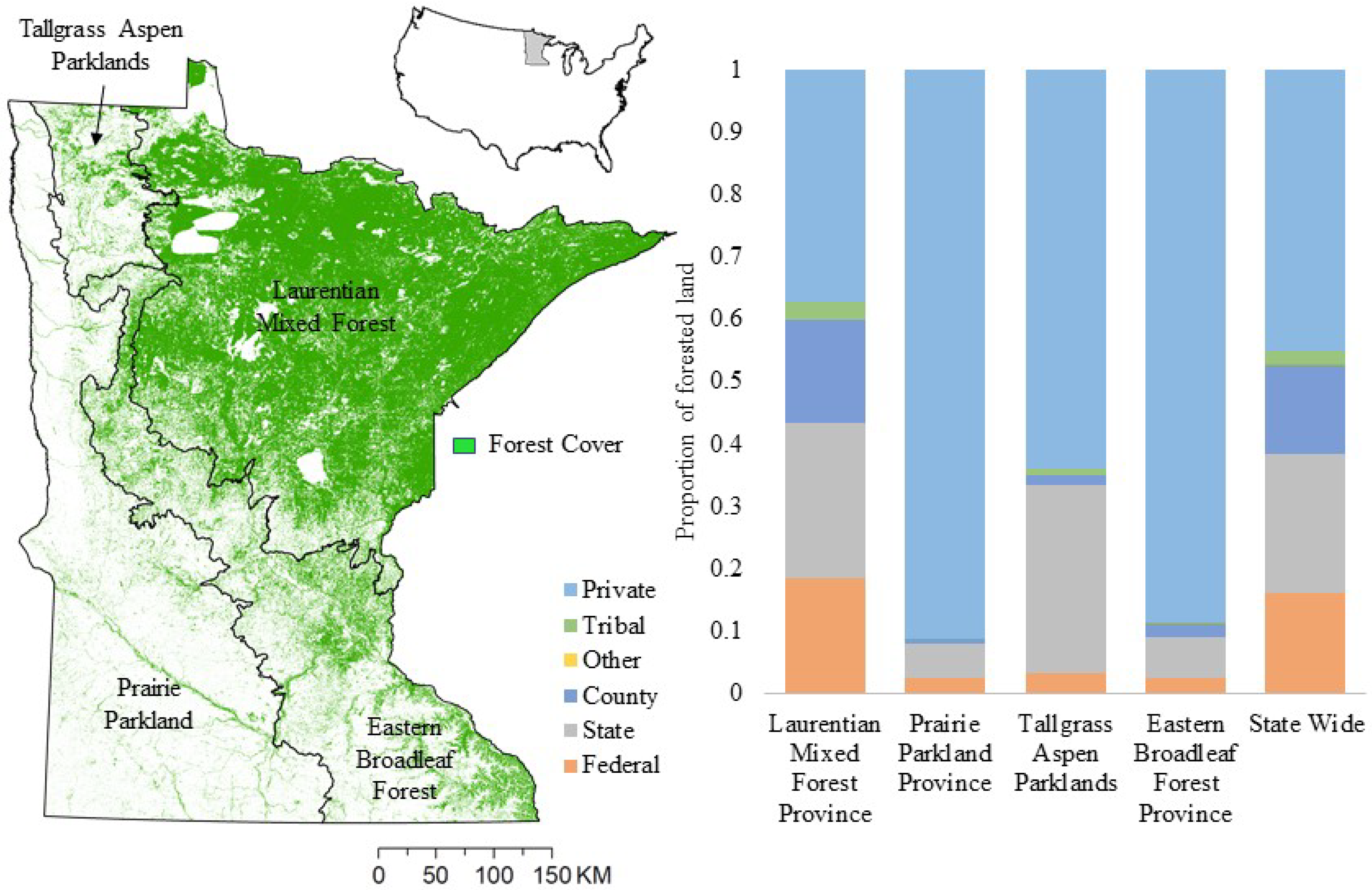
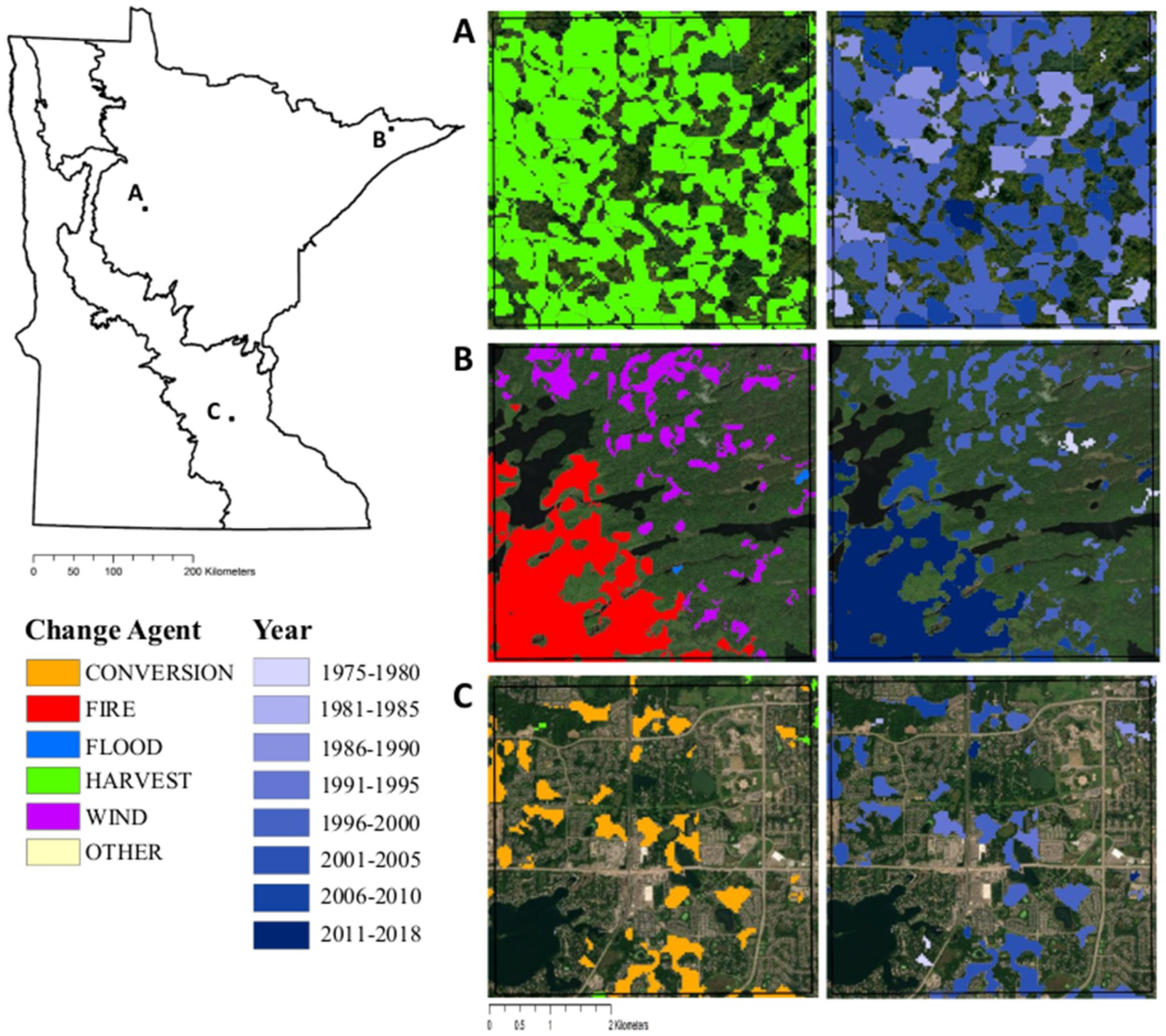
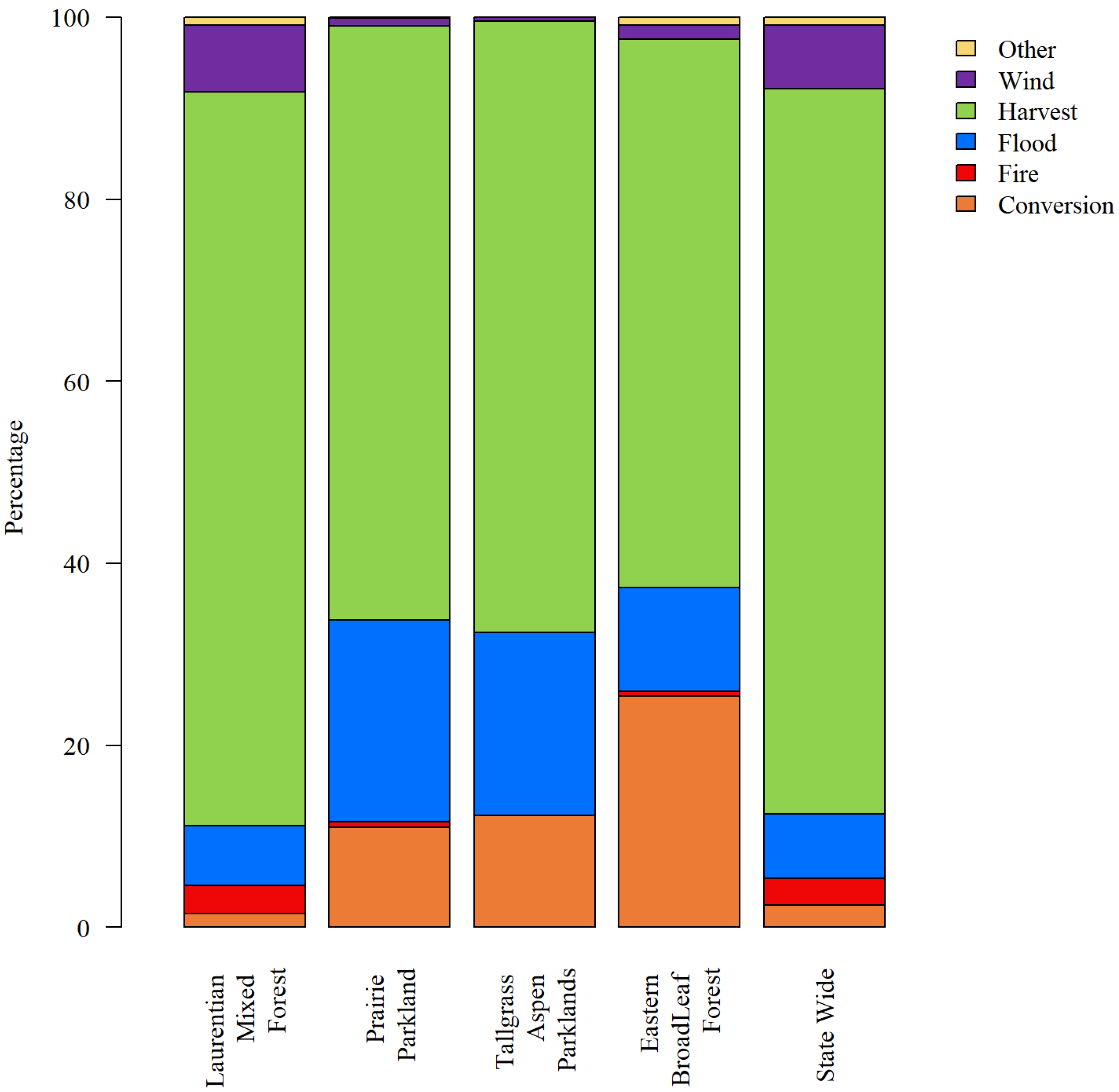
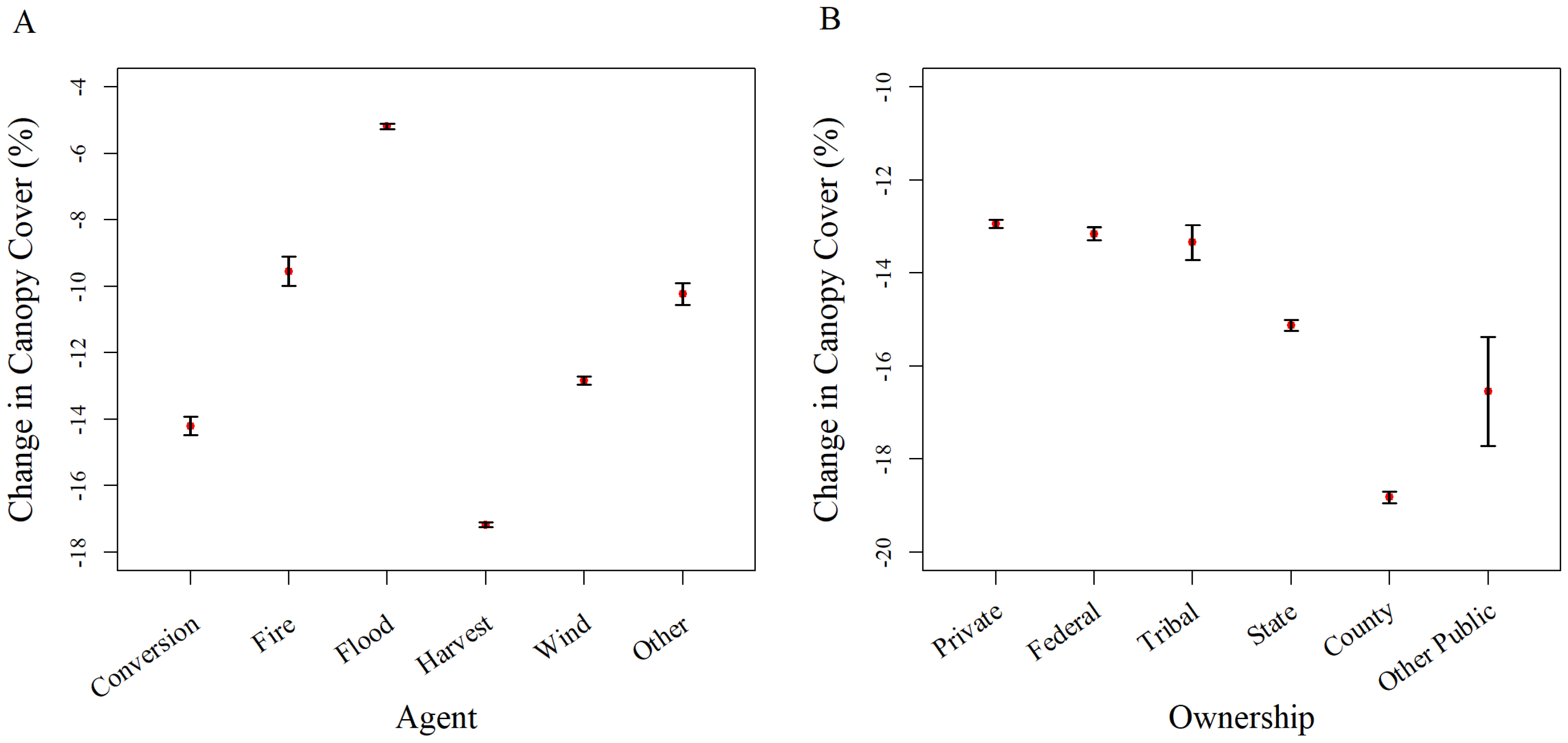
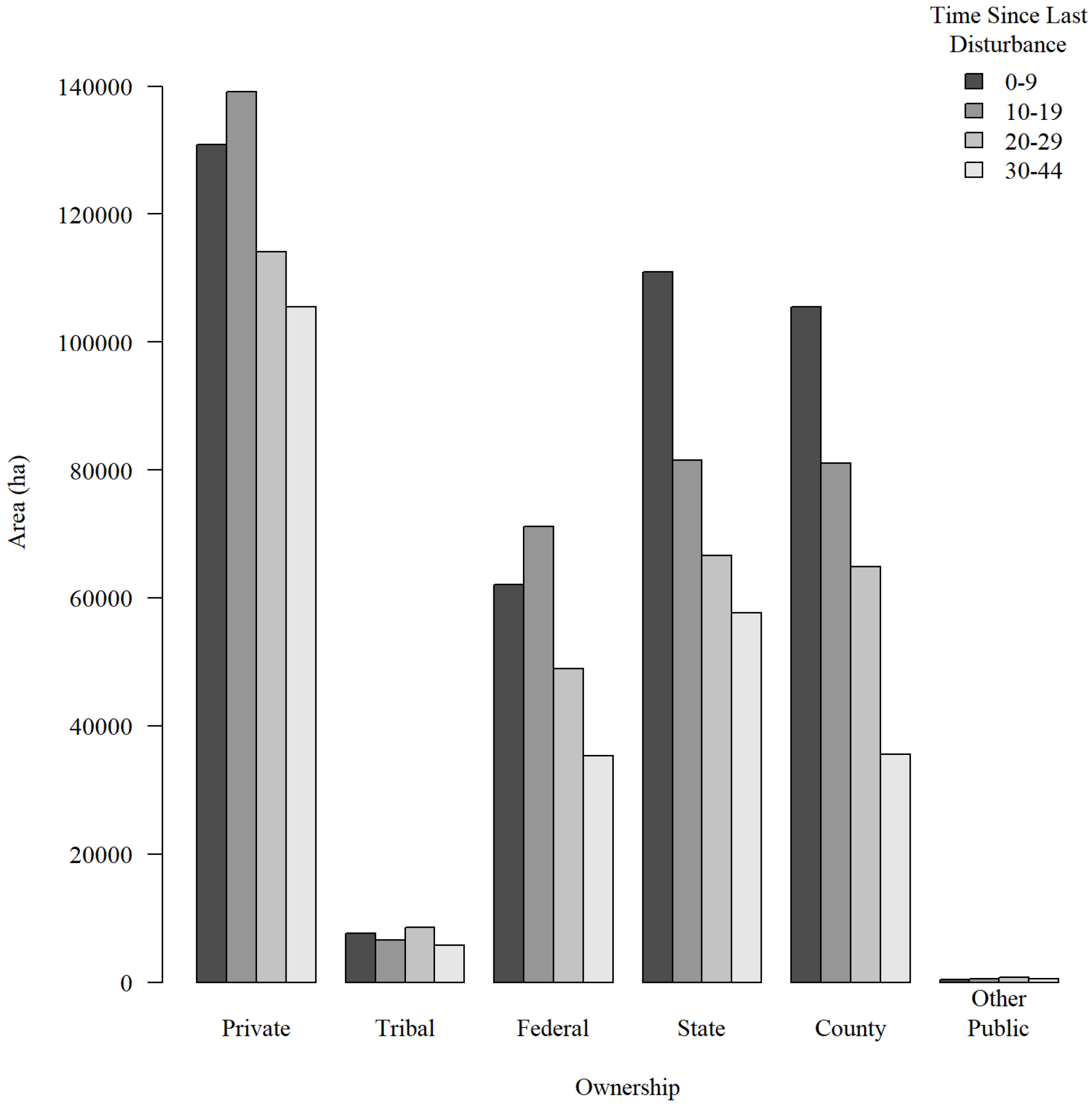
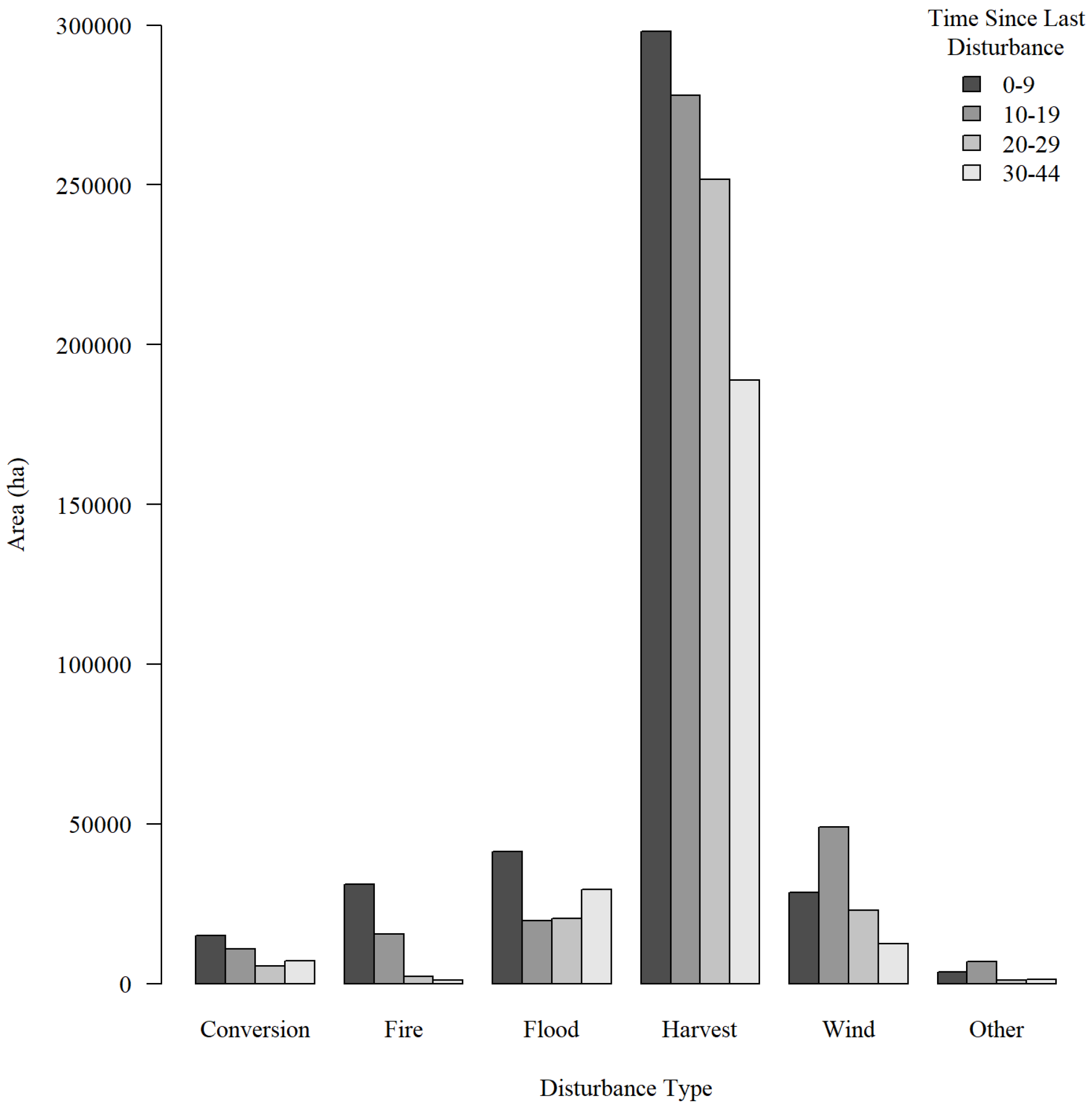
| Metric Category | Metric | Metric Description | Final 6-Class Model |
|---|---|---|---|
| SPECTRAL | TCB-Pre | Pre-disturbance tasseled-cap brightness | |
| TCG-Pre | Pre-disturbance tasseled-cap greenness | X | |
| TCW-Pre | Pre-disturbance tasseled-cap wetness | X | |
| TCA-Pre | Pre-disturbance tasseled-cap angle | ||
| TCB-Post | Post-disturbance tasseled-cap brightness | X | |
| TCG-Post | Post-disturbance tasseled-cap greenness | X | |
| TCW-Post | Post-disturbance tasseled-cap wetness | X | |
| TCA-Post | Post-disturbance tasseled-cap angle | ||
| TCB-Mag | TCB magnitude of change | X | |
| TCG-Mag | TCG magnitude of change | X | |
| TCW-Mag | TCW magnitude of change | X | |
| TCA-Mag | TCA magnitude of change | ||
| TCB-Rec | TCB post event recovery magnitude | ||
| TCG-Rec | TCG post event recovery magnitude | ||
| TCW-Rec | TCW post event recovery magnitude | ||
| TCA-Rec | TCA post event recovery magnitude | ||
| TCB-Cur | TCB current value | ||
| TCG-Cur * | TCG current value | X | |
| TCW-Cur | TCW current value | X | |
| TCA-Cur | TCA current value | X | |
| CANOPY COVER | Cover-Pre * | Pre-disturbance canopy cover | X |
| Cover-Post | Post-disturbance canopy cover | X | |
| Cover-Mag * | Difference between Cover-Post and Cover-Pre | X | |
| Cover-Cur | Current canopy cover | X | |
| PATCH CHARACTERISTICS | Area | Area of the disturbance patch (m2) | |
| Perimeter | Perimeter of the disturbance patch (m) | ||
| AP-Ratio | Ratio of perimeter to area | X | |
| TOPOGRAPHIC | Elevation | Mean elevation | X |
| Hillslope-250 m | Hillslope position index 250 m radii | ||
| Hillslope-500 m | Hillslope position index 500 m radii | X | |
| Landscape | Landscape position index | ||
| MANAGEMENT STATUS | PAD-US | PAD-US protection classification (1–4) | X |
| LANDCOVER CLASSES | Wet | Proportion patch within National Land Cover Dataset (NLCD) classes: open water + emergent herbaceous wetlands | X |
| Wet-All | Proportion patch within NLCD classes: open water + emergent herbaceous wetlands + woody wetlands | X |
| Error Matrix | Accuracy | ||||
|---|---|---|---|---|---|
| Non-Disturbed | Disturbed | User’s | Producer’s | Overall | |
| Non-Disturbed | 0.827 | 0.025 | 97.0 (2.2) | 99.7 (0.3) | 97.2 (1.9) |
| Disturbed | 0.002 | 0.145 | 98.4 (1.9) | 85.1 (9.3) | |
| Observed | ||||||||
|---|---|---|---|---|---|---|---|---|
| Non-Disturbed | Conversion | Fire | Flood | Harvest | Wind | Other | ||
| Predicted | Non-Disturbed | 0.827 | 0 | 0 | 0 | 0.025 | 0 | 0 |
| CONVERSION | 0 | 0.004 | <0.001 | <0.001 | <0.001 | 0 | 0 | |
| FIRE | 0 | <0.001 | 0.005 | 0 | <0.001 | <0.001 | 0 | |
| FLOOD | <0.001 | <0.001 | 0 | 0.011 | 0.001 | 0 | <0.001 | |
| HARVEST | 0.002 | 0 | 0 | 0.001 | 0.107 | 0.002 | 0 | |
| WIND | <0.001 | 0 | 0 | 0 | 0.002 | 0.010 | 0 | |
| OTHER | <0.001 | 0 | 0 | 0 | <0.001 | 0 | 0.001 | |
| Accuracy | |||
|---|---|---|---|
| User’s | Producer’s | Overall | |
| Non-Disturbed | 97.0 (2.2) | 99.7 (0.3) | 96.5 (1.9) |
| CONVERSION | 92.9 (6.2) | 92.6 (8.9) | |
| FIRE | 90.2 (6.6) | 98.8 (2.4) | |
| FLOOD | 89.7 (7.4) | 91.3 (15.0) | |
| HARVEST | 95.6 (3.8) | 78.6 (10.9) | |
| WIND | 80.0 (9.0) | 83.1 (19.2) | |
| OTHER | 89.6 (7.0) | 87.5 (21.8) | |
| Percent of Disturbance Agents by Ownership | Percent of Total Disturbed Forest | ||||||
|---|---|---|---|---|---|---|---|
| Conversion | Fire | Flood | Harvest | Wind | Other | ||
| State | 0.57 | 0.86 | 9.17 | 83.61 | 5.04 | 0.75 | 25.19 |
| Federal | 0.25 | 16.87 | 5.15 | 52.72 | 23.46 | 1.54 | 9.96 |
| Private | 5.72 | 0.44 | 7.21 | 82.10 | 3.81 | 0.71 | 37.93 |
| Tribal | 1.51 | 0.06 | 11.37 | 83.20 | 3.52 | 0.34 | 2.24 |
| County | 0.68 | 0.24 | 5.68 | 89.16 | 3.50 | 0.73 | 24.51 |
| Other Public | 10.95 | 0.36 | 5.59 | 79.68 | 3.27 | 0.15 | 0.17 |
| State Wide | 2.48 | 2.94 | 7.02 | 79.71 | 7.02 | 0.84 | |
© 2020 by the authors. Licensee MDPI, Basel, Switzerland. This article is an open access article distributed under the terms and conditions of the Creative Commons Attribution (CC BY) license (http://creativecommons.org/licenses/by/4.0/).
Share and Cite
Vogeler, J.C.; Slesak, R.A.; Fekety, P.A.; Falkowski, M.J. Characterizing over Four Decades of Forest Disturbance in Minnesota, USA. Forests 2020, 11, 362. https://doi.org/10.3390/f11030362
Vogeler JC, Slesak RA, Fekety PA, Falkowski MJ. Characterizing over Four Decades of Forest Disturbance in Minnesota, USA. Forests. 2020; 11(3):362. https://doi.org/10.3390/f11030362
Chicago/Turabian StyleVogeler, Jody C., Robert A. Slesak, Patrick A. Fekety, and Michael J. Falkowski. 2020. "Characterizing over Four Decades of Forest Disturbance in Minnesota, USA" Forests 11, no. 3: 362. https://doi.org/10.3390/f11030362
APA StyleVogeler, J. C., Slesak, R. A., Fekety, P. A., & Falkowski, M. J. (2020). Characterizing over Four Decades of Forest Disturbance in Minnesota, USA. Forests, 11(3), 362. https://doi.org/10.3390/f11030362





